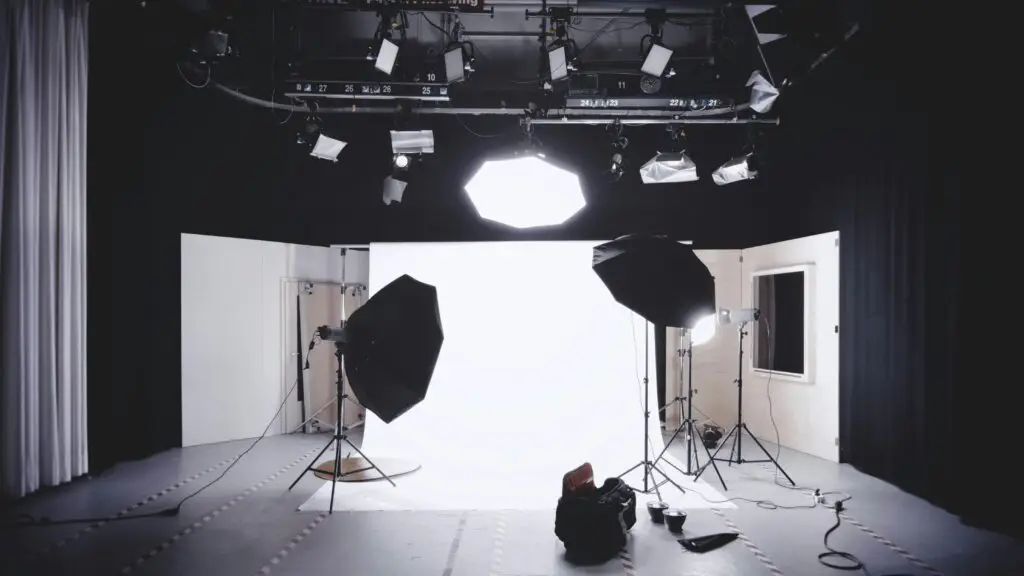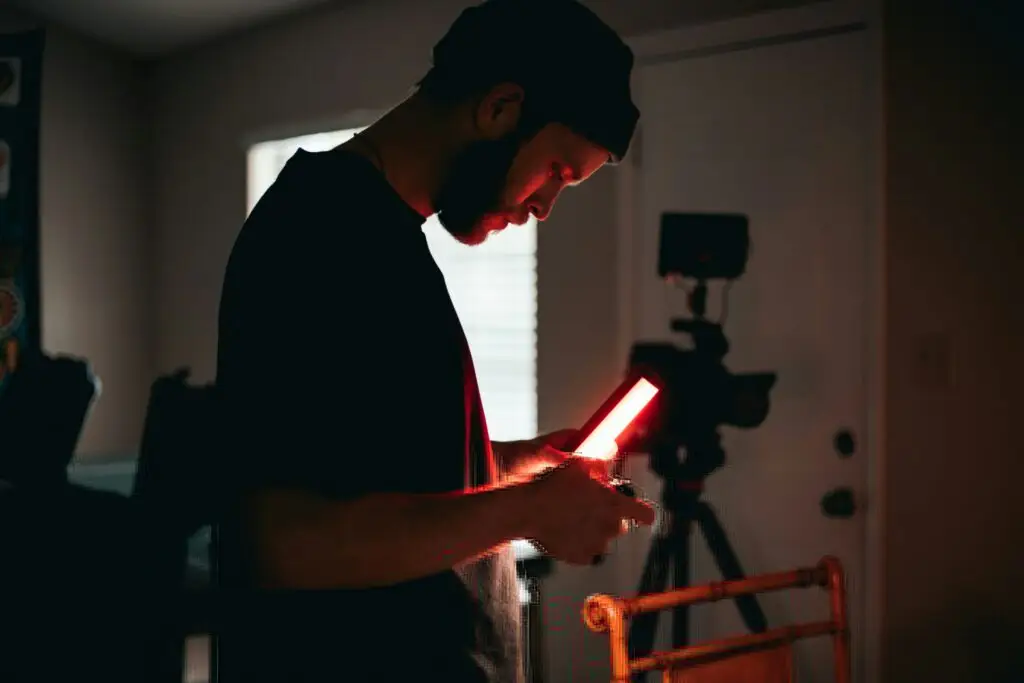Lighting is often the unsung hero of video production. It’s not just about visibility—it sets the mood, guides the viewer’s eye, and breathes life into every frame. Whether you’re creating corporate videos or cinematic stories, lighting shapes how viewers perceive and connect with the content.
At HUSTL Media, a leading Las Vegas video production company, we understand the transformative power of effective lighting. Whether capturing raw emotion or highlighting a product, our team knows how to use light to make every scene compelling. In this blog, we’ll share key lighting tips to elevate your video projects and show how HUSTL Media can help you achieve outstanding visual storytelling in Las Vegas video productions and film production in Las Vegas.
Understanding the Basics of Lighting

Before diving into advanced lighting techniques, let’s start with some basics. Key terms like three-point lighting, color temperature, and the difference between hard and soft light are fundamental concepts that every filmmaker should understand.
Three-Point Lighting: This classic setup includes the key light (main source), fill light (to soften shadows), and backlight (to separate the subject from the background). Together, these create depth and dimension.
Color Temperature: Measured in Kelvin, color temperature impacts the warmth or coolness of light. Indoor scenes often use warmer lighting (around 3200K), while daylight has a cooler tone (around 5600K).
Hard vs. Soft Light: Hard light creates sharp, defined shadows, while soft light produces a more diffuse effect. Choosing between the two can drastically change the feel of a scene, with soft light generally providing a more flattering and natural look.
Having a solid grasp of these concepts provides a foundation for experimenting with different lighting styles and setups, ultimately enhancing your storytelling.
The Importance of Natural Light
Natural light is a beautiful, accessible tool in video production. When used correctly, it can create a warm, organic feel that’s hard to replicate with artificial lighting. But working with natural light requires careful planning and an understanding of how it shifts throughout the day.
Golden Hour Magic: The “golden hour,” which occurs shortly after sunrise or before sunset, offers soft, warm tones that are ideal for outdoor shoots. This light flatters skin tones and brings out the colors in landscapes, making it perfect for scenes that need a natural, inviting atmosphere.
Reflectors and Diffusers: Reflectors help bounce sunlight to fill in shadows, while diffusers soften harsh midday sunlight. Both are essential tools when shooting outdoors and can make a big difference in managing sunlight’s intensity and direction.
When we shoot projects at HUSTL Media, we always consider how natural light can add to the narrative. With the right techniques, we can harness the power of sunlight to capture stunning, cinematic visuals that don’t rely on expensive equipment.
Artificial Lighting Techniques
While natural light is incredible, there are times when artificial lighting becomes essential, especially for indoor or controlled environments. Here’s a breakdown of common artificial lighting options and when to use them:
LED Lights: Versatile and energy-efficient, LED lights come in various color temperatures and brightness levels. They’re perfect for everything from interviews to commercial shoots, providing a consistent, easily adjustable light source.
Softboxes: These are ideal for creating soft, even lighting with minimal shadows, which is flattering for subjects and excellent for interviews or beauty shots.
Ring Lights: Commonly used in social media and beauty videos, ring lights offer a flattering, shadow-free light when placed directly in front of the subject. They’re particularly effective for close-ups, giving the eyes a subtle, appealing catchlight.
Choosing the right type of light depends on the setting and the effect you want. At HUSTL Media, we tailor our lighting setups to match each project’s unique needs, ensuring that every frame is visually captivating.
Creating Mood and Atmosphere Through Lighting Techniques
Lighting techniques can do so much more than illuminate; it can transform a scene’s emotional tone. Here’s how different techniques can create distinct atmospheres:
Colored Gels: Adding colored gels over lights can give scenes a unique ambiance. For example, blue gels create a cold, eerie feel, perfect for suspenseful scenes, while warmer colors like orange and red evoke coziness or intensity.
Shadows and Contrast: High-contrast lighting, achieved by positioning lights to create deep shadows, can add a sense of mystery or drama to a scene.
Backlighting: Placing a light behind the subject creates a silhouette effect that can add intrigue or separate the subject from the background, enhancing depth and drawing attention to the main focus.
With HUSTL Media, we’re experts at crafting the right mood for each project. We understand how to use lighting creatively, ensuring that every scene not only looks beautiful but also connects emotionally with viewers.
Mastering Light Placement

Proper light placement is crucial for achieving a polished, professional look. Here are some tips on how to position lights effectively:
Angles Matter: Light placement impacts shadows and highlights, so experiment with different angles to find what works best for your subject and scene. Lighting from above, for example, can create a natural look, while lighting from below often results in a more dramatic effect.
Distance and Intensity: The closer the light is to the subject, the more intense it will be. Experimenting with distance can help you find the right balance for the look you want.
Height: Placing the light slightly above eye level often produces a flattering effect for most subjects, especially for interviews or talking-head shots.
Each type of scene has its ideal lighting setup, and at HUSTL Media, we know how to apply these techniques to maximize visual appeal. Whether shooting a commercial or narrative video, we use strategic light placement to enhance the quality of every shot.
Troubleshooting Common Lighting Issues
Lighting can be tricky, and even the best setups can sometimes go awry. Here are a few common lighting issues and how to address them:
Harsh Shadows: Softboxes or diffusers can help soften harsh shadows, especially in interviews or close-ups.
Overexposure: Adjusting the light source’s intensity or repositioning it further away can prevent overexposure and help maintain the scene’s details.
Color Imbalance: Mixing light sources with different color temperatures can result in an unflattering, mismatched look. Using matching lights or adjusting color temperatures in post-production can solve this problem.
When we face these challenges, our team at HUSTL Media knows how to adapt quickly, ensuring that the final product remains visually cohesive and professional.
The Role of Lighting Techniques in Post-Production
Lighting doesn’t end on set; it plays a crucial role in post-production as well. Consistent lighting across all scenes is essential, as mismatched lighting can disrupt the flow and distract viewers.
In post-production, we use color correction and grading tools to adjust lighting, ensuring that every shot looks its best and aligns with the project’s tone. At HUSTL Media, we prioritize lighting consistency to create a polished, cohesive video that captivates viewers from start to finish.
Why Hire HUSTL Media

Working with HUSTL Media means gaining access to a team of lighting experts who know how to capture stunning visuals for any project. Here’s what sets us apart:
Expertise in Lighting Techniques: From natural light to complex artificial setups, we bring a wealth of knowledge to every project.
State-of-the-Art Equipment: We use industry-leading lighting tools to achieve the highest-quality visuals, ensuring your brand shines on screen.
Commitment to Storytelling: We believe lighting should serve the narrative, enhancing emotions and guiding the viewer’s experience.
If you’re looking for a partner who understands the art and science of lighting, HUSTL Media has the skills and passion to bring your vision to life.
Conclusion
In Las Vegas video production, lighting can make or break a project. It shapes mood, directs attention, and enhances storytelling. By mastering these techniques and partnering with a professional video production company like HUSTL Media, you can elevate your content to new heights. Remember, great lighting isn’t just about visibility—it’s about feeling. Whether you’re working on an ad campaign or a personal project, don’t underestimate the power of effective lighting in Las Vegas video production or video production in Las Vegas.
FAQs
Q: Why is lighting so important in video production?
Lighting enhances visibility, sets the mood, and improves the overall quality of the video. It helps guide viewers’ attention and makes content more engaging and visually appealing.
Q: What are the basics of three-point lighting?
Three-point lighting involves using a key light, fill light, and backlight to create depth and reduce shadows. It’s a versatile setup that works for interviews, product shots, and narrative scenes.
Q: How can I use natural light effectively in videos?
Shooting during golden hour offers soft, flattering light, and using reflectors or diffusers helps control sunlight’s intensity, providing beautiful, even lighting for outdoor scenes.
To book our services, kindly send us an email at Art@HUSTLMedia.com or directly call us at (702) 980 -9620. You may also learn more about us and our campaigns by visiting our website – HUSTL Media.




